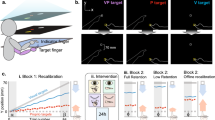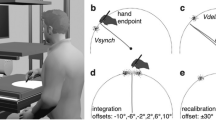Abstract
Previous studies showed that self-localisation ability involves both vision and proprioception, integrated into a single percept, with the tendency to rely more heavily on visual than proprioceptive cues. Despite the increasing evidence for the importance of vision in localising the hands, the time course of the interaction between vision and proprioception during visual occlusion remains unclear. In particular, we investigated how the brain weighs visual and proprioceptive information in hand localisation over time when the visual cues do not reflect the real position of the hand. We tested three hypotheses: Self-localisations are less accurate when vision and proprioception are incongruent; under the same conditions of incongruence, people first rely on vision and gradually revert to proprioception; if vision is removed immediately prior to hand localisation, accuracy increases. Sixteen participants viewed a video of their hands, under three conditions each undertaken with eyes open or closed: Incongruent conditions (right hand movement seen: inward, right hand real movement: outward), Congruent conditions (movement seen congruent to real movement). The right hand was then hidden from view and participants performed a localisation task whereby a moving vertical arrow was stopped when aligned with the felt position of their middle finger. A second experiment used identical methodology, but with the direction of the arrow switched. Our data showed that, in the Incongruent conditions (both with eyes open and closed), participants perceived their right hand close to its last seen position. Over time, the perceived position of the hand shifted towards the physical position. Closing the eyes before the localisation task increased the accuracy in the Incongruent condition. Crucially, Experiment 2 confirmed the findings and showed that the direction of arrow movement had no effect on hand localisation. Our hypotheses were supported: When vision and proprioception were incongruent, participants were less accurate and initially relied on vision and then proprioception over time. When vision was removed, this shift occurred more quickly. Our findings are relevant in understanding the normal and pathological processes underpinning self-localisation.



Similar content being viewed by others
References
Aglioti S, Smania N, Peru A (1999) Frames of reference for mapping tactile stimuli in brain-damaged patients. J Cognit Neurosci, 11(1):67–79. Retrieved from http://www.ncbi.nlm.nih.gov/pubmed/9950715
Azañón E, Soto-Faraco S (2008) Changing reference frames during the encoding of tactile events. Curr Biol CB 18(14):1044–1049. doi:10.1016/j.cub.2008.06.045
Block AM (1890) Expériences sur les sensations musculaires. Revue Scientifique 45:294–230
Bock O, Arnold K (1993) Error accumulation and error correction in sequential pointing movements. Exp Brain Res 95:111–117
Chapman CD, Heath MD, Westwood DA, Roy EA (2000) Memory for kinesthetically defined target location: evidence for manual asymmetries. Brain Cognit, 46(1–2):62–66. Retrieved from http://www.ncbi.nlm.nih.gov/pubmed/11527365
Cole J, Paillard J (1995) Living without touch and peripheral information about body position and movement: studies with deafferented participants. In: Bermudez JL, Marcel A, Eilan N (eds) The body and the self. MIT Press, Cambridge, pp 245–266
Craske B, Crawshaw M (1975) Shifts in kinesthesis through time and after active and passive movement. Percept Mot Skills, 40(3):755–61. Retrieved from http://www.ncbi.nlm.nih.gov/pubmed/1178361
Crowe A, Keessen W, Kuus W, Van Vliet R, Zegeling A (1987) Proprioceptive accuracy in two dimensions. Percept Mot Skills 64:831–846
Desmurget M, Vindras P, Gréa H, Viviani P, Grafton ST (2000) Proprioception does not quickly drift during visual occlusion. Exp Brain Res 134(3):363–377. doi:10.1007/s002210000473
Dijkerman HC, de Haan EHF (2007) Somatosensory processes subserving perception and action. Behav Brain Sci, 30(2):189–201; discussion 201–239. doi:10.1017/S0140525X07001392
Eimer M, Forster B, Van Velzen J (2003) Anterior and posterior attentional control systems use different spatial reference frames: ERP evidence from covert tactile-spatial orienting. Psychophysiology 40(6):924–933. doi:10.1111/1469-8986.00110
Ernst MO, Banks MS (2002) Humans integrate visual and haptic information in a statistically optimal fashion. Nature 415(6870):429–433. doi:10.1038/415429a
Ernst MO, Bülthoff HH (2004) Merging the senses into a robust percept. Trends Cognit Sci 8(4):162–169. doi:10.1016/j.tics.2004.02.002
Gallace A, Torta DME, Moseley GL, Iannetti GD (2011) The analgesic effect of crossing the arms. Pain 152(6):1418–1423. doi:10.1016/j.pain.2011.02.029
Ghilardi MF, Gordon J, Ghez C (1995) Learning a visuomotor transformation in a local area of work space produces directional biases in other areas. J Neurophysiol, 73(6):2535–2569. Retrieved from http://www.ncbi.nlm.nih.gov/pubmed/7666158
Gregory RL (1997) Eye and brain: the psychology of seeing, 5th edn. Princepton University Press, Princeton
Guariglia C, Piccardi L, Puglisi Allegra MC, Traballesi M (2002) Is autotopoagnosia real? EC says yes. A case study. Neuropsychologia, 40(10):1744–9. Retrieved from http://www.ncbi.nlm.nih.gov/pubmed/11992662
Haggard P, Wolpert DM (2001) Disorders of Body Scheme. In: Freund H-J, Jeannerod M, Hallett M, Leiguarda R (eds) Higher-order motor disorders: from neuroanatomy and neurobiology to clinical neurology. Oxford University Press, New York, pp 261–271
Haggard P, Newman C, Blundell J, Andrew H (2000) The perceived position of the hand in space. Percept Psychophys, 62(2):363–77. Retrieved from http://www.ncbi.nlm.nih.gov/pubmed/10723215
Holmes NP, Spence C (2005) Visual bias of unseen hand position with a mirror: spatial and temporal factors. Exp Brain Res. Experimentelle Hirnforschung Expérimentation Cérébrale, 166(3–4):489–497. doi:10.1007/s00221-005-2389-4
Holst E, Mittelstaedt H (1950) Das reafferenzprinzip. Naturwissenschaften 37(20):464–476
Jones SAH, Cressman EK, Henriques DYP (2010) Proprioceptive localization of the left and right hands. Exp Brain Res Experimentelle Hirnforschung. Expérimentation Cérébrale, 204(3):373–383. doi:10.1007/s00221-009-2079-8
Larson MG (2008) Analysis of variance. Circulation 117(1):115–121. doi:10.1161/CIRCULATIONAHA.107.654335
Lotze M, Moseley GL (2007) Role of distorted body image in pain. Curr Rheumatol Rep, 9(6), 488–96. Retrieved from http://www.ncbi.nlm.nih.gov/pubmed/18177603
Moseley GL (2004) Why do people with complex regional pain syndrome take longer to recognize their affected hand? Neurology 62(12):2182–2186
Moseley GL (2005) Distorted body image in complex regional pain syndrome type 1. Neurology 65:773
Moseley GL, Gallace A, Spence C (2012) Bodily illusions in health and disease: physiological and clinical perspectives and the concept of a cortical “body matrix”. Neurosci Biobehav Rev 36(1):34–46. doi:10.1016/j.neubiorev.2011.03.013
Newport R, Gilpin HR (2011) Multisensory disintegration and the disappearing hand trick. Curr Biol CB 21(19):R804–R805. doi:10.1016/j.cub.2011.08.044
Newport R, Schenk T (2012) Prisms and neglect: what have we learned? Neuropsychologia 50(6):1080–1091. doi:10.1016/j.neuropsychologia.2012.01.023
Newport R, Hindle JV, Jackson SR (2001) Links between vision and somatosensation. Vision can improve the felt position of the unseen hand. Curr Biol CB, 11(12):975–980. Retrieved from http://www.ncbi.nlm.nih.gov/pubmed/11448775
Newport R, Preston C, Pearce R, Holton R (2009) Eye rotation does not contribute to shifts in subjective straight ahead: implications for prism adaptation and neglect. Neuropsychologia 47(8–9):2008–2012. doi:10.1016/j.neuropsychologia.2009.02.017
Newport R, Pearce R, Preston C (2010) Fake hands in action: embodiment and control of supernumerary limbs. Exp Brain Res Experimentelle Hirnforschung. Expérimentation Cérébrale, 204(3):385–395. doi:10.1007/s00221-009-2104-y
Paillard J, Brouchon M (1968) Active and passive movements in the calibration of position sense. In: Freedman SJ (ed) The neuropsychology of spatially oriented behavior. Dorsey Press, Illinois, pp 35–56
Pavani F, Spence C, Driver J (2000) Visual capture of touch: out-of-the-body experiences with rubber gloves. Psychol Sci 11(5):353–359. doi:10.1111/1467-9280.00270
Pick A (1922) Störung der Orientierung am eigenen Körper. Psychologische Forschung 1(1):303–318. doi:10.1007/BF00410392
Proske U, Gandevia SC (2012) The proprioceptive senses: their roles in signaling body shape, body position and movement, and muscle force. Physiol Rev 92(4):1651–1697. doi:10.1152/physrev.00048.2011
Rossetti Y, Rode G, Pisella L, Alessandro F, Li L, Boisson D, Perenin M-T (1998) Prism adaptation to a rightward optical deviation rehabilitates left hemispatial neglect. Nature 395:166–169
Sambo CF, Torta DM, Gallace A, Liang M, Moseley GL, Iannetti GD (2013) The temporal order judgement of tactile and nociceptive stimuli is impaired by crossing the hands over the body midline. Pain 154(2):242–247. doi:10.1016/j.pain.2012.10.010
Semenza C, Goodglass H (1985) Localisation of body parts in brain injured subjects. Neuropsychologia 23(2):161–175
Smeets JBJ, van den Dobbelsteen JJ, de Grave DDJ, van Beers RJ, Brenner E (2006) Sensory integration does not lead to sensory calibration. Proc Natl Acad Sci USA 103(49):18781–18786. doi:10.1073/pnas.0607687103
Sperry RW (1950) Neural basis of the spontaneous optokinetic response produced by visual inversion. J Comp Physiol Psychol 43(6):482
Torta DM, Diano M, Costa T, Gallace A, Duca S, Geminiani GC, Cauda F (2013) Crossing the line of pain: FMRI correlates of crossed-hands analgesia. J Pain : Off J Am Pain Soc 14(9):957–965. doi:10.1016/j.jpain.2013.03.009
Van Beers RJ, Sittig AC, Denier van der Gon JJ (1998) The precision of proprioceptive position sense. Exp Brain Res 122(4):367–377. doi:10.1007/s002210050525
Van Beers RJ, Sittig AC, Denier van der Gon JJ (1999a) Localization of a seen finger is based exclusively on proprioception and on vision of the finger. Exp Brain Res Experimentelle Hirnforschung. Expérimentation Cérébrale, 125(1):43–49. Retrieved from http://www.ncbi.nlm.nih.gov/pubmed/10100975
Van Beers RJ, Sittig AC, Van Der Gon JJD (1999b) Integration of proprioceptive and visual position-information: an experimentally supported model. J Neurophysiol 81(3):1355–1364
Van Beers RJ, Wolpert DM, Haggard P (2002) When feeling is more important than seeing in sensorimotor adaptation. Curr Biol CB, 12(10):834–837. Retrieved from http://www.ncbi.nlm.nih.gov/pubmed/12015120
Wann JP (1991) The integrity of visual-proprioceptive mapping in cerebral palsy. Neuropsychologia, 29(11):1095–1106. Retrieved from http://www.ncbi.nlm.nih.gov/pubmed/1775227
Wann JP, Ibrahim SF (1992) Does limb proprioception drift? Exp Brain Res Experimentelle Hirnforschung. Expérimentation Cérébrale 91(1):162–166. Retrieved from http://www.ncbi.nlm.nih.gov/pubmed/1301369
Yamamoto S, Kitazawa S (2001) Reversal of subjective temporal order due to arm crossing. Nat Neurosci 4(7):759–765. doi:10.1038/89559
Acknowledgments
We would like to thank Ms. Cat Jones for her help in creating the video of the Adaptation Procedure.
Author information
Authors and Affiliations
Corresponding author
Electronic supplementary material
Below is the link to the electronic supplementary material.
Supplementary material 1 (MP4 9164 kb)
Rights and permissions
About this article
Cite this article
Bellan, V., Gilpin, H.R., Stanton, T.R. et al. Untangling visual and proprioceptive contributions to hand localisation over time. Exp Brain Res 233, 1689–1701 (2015). https://doi.org/10.1007/s00221-015-4242-8
Received:
Accepted:
Published:
Issue Date:
DOI: https://doi.org/10.1007/s00221-015-4242-8




